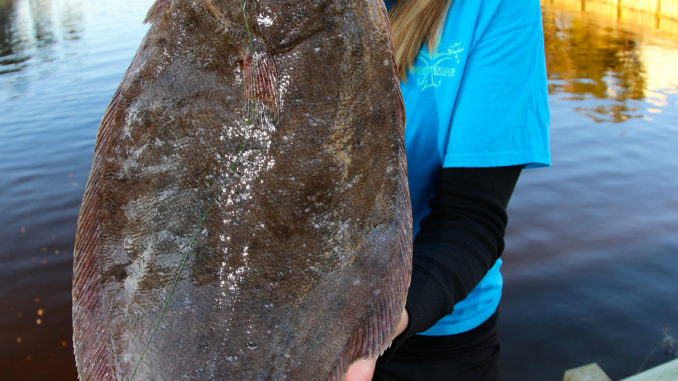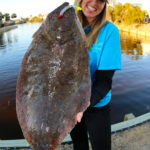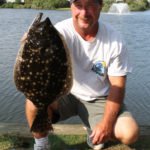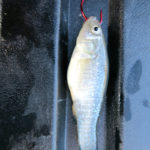
Don’t ignore saltwater ponds in April. They’re full of fish, especially big flounder.
A handful of anglers fishing a pond in Pawleys Island reeled in some grass, pine straw and a small pinfish, prompting a comment from an onlooker: “This pond isn’t worth fishing.”
Meanwhile, Paul Dunagan of Garden City was standing on the edge of the pond, slowly turning the handle of his spinning reel. He paused, then set the hook. His rod doubled over, causing a ruckus among the others. A minute later, Dunagan netted a hefty flounder and tossed it in his cooler.
Dunagan then fielded questions from the other anglers about bait, gear and techniques. It’s a scene he has played out many times while fishing the saltwater ponds along the Hammock Coast, and he delights in sharing his knowledge of these often-overlooked waterways.
“A lot of people pass by saltwater ponds to go surf-fishing, pier-fishing or fishing from a boat and never realize they can catch just as many quality fish in these ponds as anywhere else,” said Dunagan, who works in a resort community that is home to several saltwater ponds. That convenience of having a place to fish after work without having to go anywhere is what got him started pond-fishing, but the quality of the fish is what has kept him at it for several years.
April, according to Dunagan, is a great month to catch flounder in saltwater ponds, so once his workday ends, he can be found slowly dragging mud minnows or mullet along the bottom. But like most things, it’s not as simple as it seems.
“A lot of people just cast out as far as they can toward the middle of the pond, but that is rarely where the fish are,” said Dunagan, who has learned over the years that the edges of these ponds are almost always the best bet for flounder, especially when a spillway is nearby.
“If the pond has a spillway, then the best time to fish is on the incoming tide,” he said. “The fish will stack up around that spillway to ambush all the baitfish that get washed in. Sometimes casting right into the churning, incoming waters will get a bite, but other times, the place to put your bait is in the calm water that is just on the edge of that churning water. The flounder love to hang out on that edge, then move into the incoming water to grab some baitfish, then back to the edge where they can relax a little.”
A lot of saltwater ponds have wooden walls built around the banks to control erosion and make adjoining walkways safer. These walls are another great place to find fish.
“People catch far more fish against those walls than anyone catches out in the middle of the ponds. Baitfish hide in all the nooks of the walls, and the flounder hang out to ambush them,” Dunagan said.
For bait, Dunagan said nothing works better than the local baitfish.
“At low tide, baitfish are easy to catch with a cast net, and I keep the bait in a Flow Troll bait bucket,” he said. “Those buckets allow you to keep bait for days, because fresh water is constantly flowing through, which means the minnows always have fresh oxygen,” he said.
Medium to medium-heavy rods in the 6 1/2- to 7 1/2-foot range are commonly used at these ponds.
“Some guys bring big, heavy duty surf rods, but they are overkill,” said Dunagan, who prefers No. 1 circle hooks and 10- to 12-pound test line. “And a lot of people put way too much weight on their line. The water isn’t moving very fast in these ponds, so you don’t need a heavy weight to keep your bait from getting washed away. I use the smallest bass-fishing weights I can find. I never use anything over 1/4-ounce. Using anything heavier lets the fish feel that resistance and keeps you from feeling bites that are often subtle,” he said.
Dunagan said anglers who cast and let their baits sit stationary on the bottom will catch a lot of small spots and croakers. He likes to keep his bait moving but makes sure to move it slowly. Sometimes, instead of reeling his bait in, Dunagan will cast along the wooden seawall, then walk slowly down the edge of the pond. This allows him to keep a set amount of line out, only reeling when he hooks a fish. It is his way of trolling without a boat.
“Flounder will lie still for a long time, just waiting on baitfish to swim past them,” he said. “If your bait is sitting still, not many flounder are going to see it unless you just happen to cast right on top of them. Keep that bait moving, and you’ll reel it past some flounder. Plus, baits that are moving attract other fish, like redfish and sea trout.”
April can be a tough month for fishermen, but not for fish.
“April weather can range from hot enough to wear shorts and a t-shirt to cold enough to wear a coat and gloves,” Dunagan said. “But once temperatures are warm for a few days in a row, a cold front won’t usually shut the fish down. It will keep a lot of anglers indoors because they don’t like the cold, but the flounder don’t seem to mind it that much, unless it is a brutal, week-long cold snap. You may have to slow your retrieve even more than normal, but sometimes a day or two of cold weather can actually turn the flounder on. It’s not an exact science, but I will rarely pass up a chance to fish during April just because it cools off.”
Dunagan’s favorite time to fish ponds in April is late afternoon and evening; he’s off work and can hit the water more easily, but that isn’t the only reason.
“On most April days, the sun warms the water up pretty good, and as evening comes, the fish sense things cooling off. They seem to feed pretty hard right then,” he said. “If I could have it my way, the tide would be coming in around 6 o’clock as the sun is getting ready to set. When things work out that way this month, that’s going to be a good day of fishing.”
While he catches more flounder than anything else in April, Dunagan also catches redfish, speckled trout and sheepshead.
“A lot of people are surprised by the sheepshead, but they are definitely in here and biting this month,” said Dunagan who explained that wooden sea walls are good places to target them with fiddler crab and shrimp baits cast tight to the walls, pilings, any concrete or metal structures like culverts that are also used for spillways, of big groups of rocks.
Redfish and trout will hit a variety of baits and lures in April, according to Dunagan.
“Live shrimp are good bets, and they will catch redfish and trout either along the bottom or under a popping cork. They will hit minnows and mullet, too, and I often catch one of them while I’m flounder fishing. Some days, I will catch more of them than flounder, but this month, flounder is definitely the king,” he said.







Be the first to comment